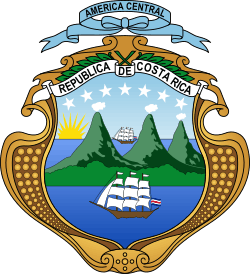Tourism in Costa Rica
Tourism in Costa Rica has been one of the fastest growing economic sectors of the country[2] and by 1995 became the largest foreign exchange earner.[3][4] Since 1999, tourism has earned more foreign exchange than bananas, pineapples and coffee exports combined.[5] The tourism boom began in 1987,[3] with the number of visitors up from 329,000 in 1988, through 1.03 million in 1999, over 2 million in 2008, to a historical record of 2.66 million foreign visitors in 2015.[6][7] In 2012, tourism contributed with 12.5% of the country's GDP and it was responsible for 11.7% of direct and indirect employment.[8] In 2009, tourism attracted 17% of foreign direct investment inflows, and 13% in average between 2000 and 2009.[9] In 2010, the tourism industry was responsible for 21.2% of foreign exchange generated by all exports.[10] According to a 2007 report by ECLAC, tourism contributed to a reduction in poverty of 3% in the country.[9]
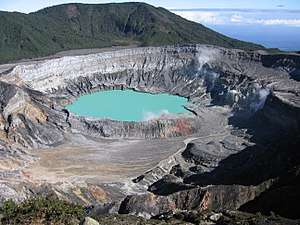

Since the late 1980s, Costa Rica became a popular nature travel destination, and its main competitive advantage is its well-established system of national parks and protected areas,[11] covering around 23.4% of the country's land area,[12] the largest in the world as a percentage of the country's territory,[13][14] and home to a rich variety of flora and fauna, in a country that has only 0.03% of the world's landmass, but that is estimated to contain 5% of the world's biodiversity.[15][16] The country also has plenty of beaches, both in the Pacific Ocean and the Caribbean Sea, within short travel distances, and also several volcanoes that can be visited with safety. By the early 1990s, Costa Rica became known as the poster child of ecotourism,[16] with tourist arrivals reaching an average annual growth rate of 14% between 1986 and 1994.[3][17]
According to the Costa Rican Tourism Board, 47% of international tourists visiting the country in 2009 engaged in activities related to ecotourism, which includes trekking, flora, fauna, and bird watching, and visits to rural communities. However, most visitors look for adventure activities.[18] Costa Rica was included by Ethical Traveler magazine in the 2011 and the 2012 list of The Developing World's 10 Best Ethical Destinations.[19][20]
Description and key statistics

Costa Rica stands as the most visited nation in the Central American region, with 3.0 million foreign visitors in 2018. During the same year, Panama was ranked second in the region with 2.5 million,[21] followed by Guatemala with 2.4 million visitors.[22]
The number of tourists visiting Costa Rica surpassed the 2 million milestone in 2008, and tourist-related income reached US$2.1 billion that year.[23] As a result of the Great Recession, international arrivals began falling since August 2008, as the number of U.S. citizens visiting the country shrank, and this market segment represented 54% of all foreign tourists visiting Costa Rica.[24]
| Year | Arrivals (x1000) |
Year | Arrivals (x1000) |
Year | Arrivals (x1000) |
Receipts USD million |
Year | Arrivals (x1000) |
Receipts USD million |
|---|---|---|---|---|---|---|---|---|---|
| 1988 | 329 | 1996 | 781 | 2004 | 1,453 | 1,358 | 2012 | 2,343 | 2,313 |
| 1989 | 376 | 1997 | 811 | 2005 | 1,679 | 1,570 | 2013 | 2,428 | 2,665 |
| 1990 | 435 | 1998 | 943 | 2006 | 1,725 | 1,732 | 2014 | 2,527 | 2,864 |
| 1991 | 504 | 1999 | 1,032 | 2007 | 1,973 | 1,974 | 2015 | 2,660 | 2,882 |
| 1992 | 611 | 2000 | 1,088 | 2008 | 2,089 | 2,144 | 2016 | 2,925 | 3,716 |
| 1993 | 684 | 2001 | 1,131 | 2009 | 1,923 | 2,075 | 2017 | 2,960 | 3,876 |
| 1994 | 762 | 2002 | 1,113 | 2010 | 2,100 | 1,999 | |||
| 1995 | 785 | 2003 | 1,239 | 2011 | 2,192 | 2,152 | |||
The combined effect of the global economic crisis and the 2009 flu pandemic resulted in a reduction of tourists arrivals in 2009 to 1.9 million visitors, an 8% reduction as compared to 2008.[34] In 2010, the number of visitors rose to 2.1 million, barely exceeding the 2008 peak,[10] and a record was reached in 2012 with 2.34 million visitors, a 6.9% increase over 2011.[26]
A historical record of 2.5 million international visitors arrived in the country in 2014, up 4.1% year-on-year, and the corresponding receipts rose to US$2.636 billion in 2014, up 8.3% from the previous year.[25] In addition, the average expenditure per tourist increased from US$1,171 in 2010 to US$1,431 in 2014, and the average stay increased from 11 days in 2010 to 13.4 in 2014.[7] Costa Rica achieved new records in 2016 with 2.93 million visitors and total earnings of US$3.716 billion.[33] The country finally reached the 3 million tourists' milestone in 2018.
In terms of the 2017 Travel and Tourism Competitiveness Index (TTCI), Costa Rica reached the 38th place in the world ranking, classified as the fourth most competitive among Latin American countries after Mexico (22), Brazil (27) and Panama (35), and ranking sixth in the Americas.[35] Just considering the subindex measuring natural resources, Costa Rica ranks in the 3rd place at a worldwide level, 21st in the world when considering international openness criteria, and 24th worldwide when considering the subindex measuring prioritization of travel and tourism. The 2017 TTCI report also notes Costa Rica's main weaknesses are price competitiveness (108th) and ground and port infrastructure (99th), with quality of the roads ranking 123th and ground transport efficiency 108th between 138 countries analyzed.
In 2012, most visitors came from the United States (39.3%), Nicaragua (20.2%), Canada (6.5%), Panama (3.9%), and Mexico (2.9%).[36] Tourists from North America and European countries made up 60.8% of all international visitors, and visitors from Central America represented 30.8%.[36] According to a 2006 survey, visitors from the Caribbean Basin and South America travel to Costa Rica mainly for business or professional purposes, while a majority of Americans, Canadians and Europeans visit the country for leisure. Word of mouth from friends and family, with an average of 58%, was the leading reason for visiting Costa Rica for vacations and leisure. The main visitor's complaint is the poor condition of the roads.[5]
| Top 30 visitor arrivals by country of origin in 2018[37] | |||||||
|---|---|---|---|---|---|---|---|
| Ranking | Country of origin |
Visitor arrivals 2018 |
% Yearly growth |
Ranking | Country of origin |
Visitor arrivals 2018 |
% Yearly growth |
| 1 | 1,265,067 | 5.5 | 16 | 32,561 | 7.4 | ||
| 2 | 416,915 | -3.0 | 17 | 29,171 | 0.4 | ||
| 3 | 217,006 | 7.5 | 18 | 28,884 | 13.7 | ||
| 4 | 98,918 | -7.4 | 19 | 22,329 | 3.9 | ||
| 5 | 92,802 | -11.4 | 20 | 18,297 | 35.5 | ||
| 6 | 76,937 | -5.1 | 21 | 15,249 | 12.0 | ||
| 7 | 74,574 | 5.1 | 22 | 14,865 | 12.1 | ||
| 8 | 74,338 | -2.4 | 23 | 14,359 | -1.3 | ||
| 9 | 74,032 | 6.1 | 24 | 12,381 | 0.9 | ||
| 10 | 68,634 | -1.2 | 25 | 11,159 | -9.4 | ||
| 11 | 65,633 | -15.9 | 26 | 11,117 | 11.3 | ||
| 12 | 46,723 | -2.6 | 27 | 8,236 | 11.1 | ||
| 13 | 40,832 | 31.8 | 28 | 8,089 | 5.2 | ||
| 14 | 38,135 | -5.4 | 29 | 6,574 | 7.4 | ||
| 15 | 33,197 | -17.6 | 30 | 6,460 | 8.5 | ||
| Visitor arrivals by region of origin in 2018 (Top 4) | |||||||
| 1 | North America | 1,580,991 | 4.8 | 3 | Europe | 480,102 | 3.9 |
| 2 | Central America | 691,386 | -6.0 | 4 | South America | 190,413 | 5.0 |
Comparative performance in the Latin American market
The following table presents a comparison of Costa Rica's tourism industry performance with selected countries from the Caribbean Basin and South America, including Bahamas, Cuba, and several of the top ten Latin American countries according to their 2013 Travel and Tourism Competitiveness Index (TTCI), which are competitors in the nature travel market segment.
| Selected Caribbean and Latin American countries |
Internl. tourist arrivals 2012[32] (x1000) |
Internl. tourism receipts 2012[32] (million USD) |
Receipts per arrival 2012 (col 2)/(col 1) (USD) |
Arrivals per capita per 1000 pop. (estimated) 2007[23][38] |
Receipts per capita 2005[39] USD |
Revenues as % of exports goods and services[27] 2003 |
Tourism revenues as % GDP[8][27] 2012 |
% Direct & indirect employment in tourism[8][27] 2012 |
World Ranking Tourism Compet.[8] TTCI 2013 |
Index value TTCI[8] 2013 |
|---|---|---|---|---|---|---|---|---|---|---|
| 1,419 | 2,367 | 1,668 | 4,616 | 6,288 | 74.6 | 34.1 | 68.7 | n/d | ||
| 536 | 916 | 1,709 | 1,956 | 2,749 | 58.5 | 42.7 | 41.9 | 27 | 4.88 | |
| 5,677 | 6,645 | 1,170 | 26 | 18 | 3.2 | 8.9 | 8.1 | 51 | 4.37 | |
| 3,554 | 2,201 | 619 | 151 | 73 | 5.3 | 8.4 | 8.0 | 56 | 4.29 | |
| 2,175 | 2,351 | 1,081 | 26 | 25 | 6.6 | 5.1 | 5.5 | 84 | 3.90 | |
| 2,343 | 2,425 | 1,035 | 442 | 343 | 17.5 | 12.5 | 11.7 | 47 | 4.44 | |
| 2,688 | 2,283 | 849 | 188 | 169 | n/d | n/d | n/d | n/d | n/d | |
| 4,563 | 4,549 | 997 | 408 | 353 | 36.2 | 14.7 | 13.6 | 86 | 3.88 | |
| 1,986 | 2,043 | 1,029 | 628 | 530 | 49.2 | 25.7 | 23.8 | 67 | 4.08 | |
| 23,403 | 12,739 | 544 | 201 | 103 | 5.7 | 12.4 | 13.7 | 44 | 4.46 | |
| 1,606 | 2,259 | 1,406 | 330 | 211 | 10.6 | 10.1 | 9.6 | 37 | 4.54 | |
| 2,846 | 2,657 | 933 | 65 | 41 | 9.0 | 9.1 | 7.8 | 73 | 4.00 | |
| 2,695 | 2,076 | 770 | 525 | 145 | 14.2 | 10.2 | 9.7 | 59 | 4.23 |
- Notes: Green shadow denotes the country with the top indicator. Yellow shadow corresponds to Costa Rica's.
(1) Visitors and receipts for Cuba correspond to 2011. For Bahamas tourism revenues as % GDP are for 2003, and direct and indirect employment for 2005.
Ecotourism

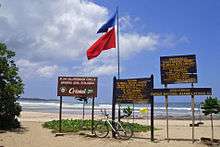
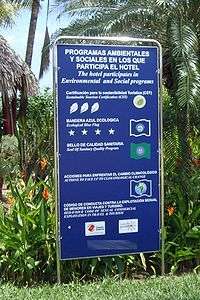
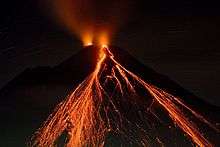
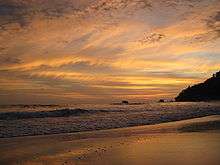
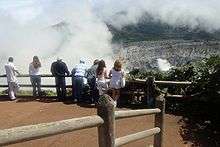
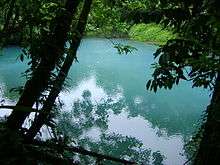
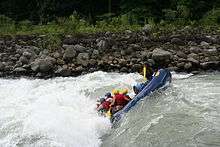
Ecotourism is extremely popular with the many tourists visiting the extensive national parks and protected areas around the country. Costa Rica was a pioneer in this type of tourism and the country is recognized as one of the few with real ecotourism.[16] In 2006, 54% international tourists visited national parks or protected areas, visiting at least two such natural refuges, and it goes up to three for European visitors.[40]
In recent years, several of Costa Rica's top travel service providers have been internationally recognized for their commitment to planet-positive tourism. Examples include Nature Air[41] and Hotel Punta Islita[42] as winners of the Tourism for Tomorrow Awards, sponsored by the World Travel and Tourism Council (WTTC), and Lapa Rios Ecolodge[43] as winner of the Rainforest Alliance Sustainable Standard-Setter.
The "Bandera Azul" Program
Implemented in 1996 and inspired by a similar program developed in Europe in 1985,[44] the "Bandera Azul Ecológica" (Ecological Blue Flag) Program is intended to promote development while curbing the negative impacts of mass tourism by helping the local community to work against pollution and protecting the environment. The program evaluates the environmental quality of coastal areas, in terms of the quality of the beaches and sea water, access and quality of drinking water, water and waste management, security, and environmental education. Depending on the degree of compliance against the optimal criteria established, a certain number of stars are awarded to the Blue Flag.[45]
After the first evaluation, ten beaches were awarded the distinction, which usually is highly publicized to potential visitors.[46] In 2008, based on the evaluation carried out in 2007, 59 beaches kept the distinction while eight beaches lost it.[45][47] In 2009, out of 81 applicants, only 61 beaches won the distinction, and just two obtained the maximum 5 stars, Playa Blanca in Punta Leona and Playa Langosta in Santa Cruz.[48]
Voluntary Certification Program
Developed in 1997 by the Costa Rican Tourism Board, the public agency responsible for tourism development and regulation in the country, a voluntary Certification for Sustainable Tourism Program (known as CST) was introduced in order to turn "the concept of sustainability into something real" by "improving the way in which the natural and social resources are utilized, to motivate the active participation of the local communities, and to support the competitiveness of the business sector."[3] The program was aimed for all types of businesses in the tourism industry, but it began only with lodging providers. By 2007, a total of 108 parameters are considered for the CST evaluation.[49]
CST hopes to encourage businesses to become sustainable in a variety of ways, including using recycled products, implementing water and energy saving devices, properly disposing and treating waste, conserving and expanding Costa Rica's forests, and developing better systems of information management.[50] As of October 2009, out of approximately 3,000 hotels and tours operators,[51] only 105 have a Certification for Sustainable Tourism.[52] Some tour operators in the U.S. and Europe promote several small hotels that hold this certification through their travel packages.[53]
Ethical Traveler Destination
Costa Rica was included in both the 2011 and 2012 lists of The Developing World's 10 Best Ethical Destinations. This is an annual ranking produced by Ethical Traveler magazine, which is based on a study of developing nations from around the world to identify the best tourism destinations among them. The benchmarking uses categories such as environmental protection, social welfare, and human rights.[19][20]
Costa Rica was absent from the list for several years because World Vision considered the country among the world's most notorious destinations for sexual predators. Even though the problem has not completely disappeared, Ethical Traveler included Costa Rica back on the 2011 list of ethical destinations due to the government's serious efforts to address human trafficking through increased public awareness campaigns, creating a new office devoted to human trafficking, and training officials.[54]
Camino de Costa Rica
The Camino de Costa Rica is a 280 km long hiking trail across Costa Rica. It runs from the Atlantic Ocean (Caribbean coast), the southern most part of the Tortuguero Canals, up the mountain and through indigenous territory near the Barbilla National Park and through valleys and mountain ranges of the central region of the country, just south of the Turrialba and Irazu Volcanos and through the Los Santos coffee region down to the Pacific coast in Quepos. By 2018, the rural population had declined from 40% inhabitants (2000) to 27% inhabitants, poverty at 25% was significantly higher than among the urban population, and income was more than 40% lower. These sobering facts as well as other factors such as level of education, unemployment and underemployment in rural areas gave rise to the NGO, the Asociación Mar a Mar in year 2016. The aim of the Camino de Costa Rica is to establish a world class long distance trail and through its success in bringing hikers from all over the world, to improve the economic situation in the rural areas of Costa Rica.
Beaches and adventure
Most of the main attractions are nature related, a combination of ecotourism with leisure and adventure activities: sun, sea and sand (55%); flora and wildlife watching (44%); visiting volcanoes (43%); trekking (41%); bird watching (30%); canopy tours (26%);bungee jumping from bridges (11%); surfing (11%); snorkeling (10%); and rafting (7%). Cultural activities such as visiting museums, art galleries and theaters corresponds to 11%, and business travel corresponds to 17%.[40]
Seven Costa Rican resorts were included in the 2012 Condé Nast Traveler Readers' Choice Awards, ranking among the top 15 resorts in Central and South America. The resorts are Xandari Resort and Spa (2), Four Seasons Resort Costa Rica at Peninsula Papagayo (3), Hotel Punta Islita (8), El Silencio Lodge and Spa (9), Los Sueños Marriott Ocean and Golf Resort (11), Arenas del Mar (12) and the Westin Playa Conchal, Resort and Spa at Playa Conchal (15). The award selection is based on surveys among the magazine's subscribers, who evaluate the resort's quality of rooms, service, food, location, design, and activities.[55][56] Two hotels were also chosen by the magazine readers among the top 5 in Central America, Hotel Grano de Oro (3) in San José and Hotel Villa Caletas (4) in Puntarenas Central Pacific.[57]
Main natural attractions
National Parks and Biological Reserves
In 2009 more than 1.2 million tourists visited national parks and protected wild reserves, up from 812 thousand visitors in 2000 and 510 thousand in 1990. Since 2003 slightly more than half the visitors are international tourists. The most visited parks are Manuel Antonio, Tortuguero, Cahuita, and the parks around the volcanoes Poás, Arenal and Irazú.[58]
Other favorite national parks and wild reserves are:
- Cocos Island, UNESCO World Heritage Site, ranked among the final top 77 nominees in the contest to choose the world's New 7 Wonders of Nature.[1][59]
- Area de Conservación Guanacaste, UNESCO World Heritage Site,
- La Amistad International Park, UNESCO World Heritage Site, Border Costa Rica-Panama
- Corcovado National Park
- Chirripó National Park
- Tapantí National Park
- Braulio Carrillo National Park
- La Selva Biological Station, Organization for Tropical Studies (private reserve)
- Monteverde Cloud Forest Reserve, Monteverde, Puntarenas (private reserve)
Volcanoes
- Poás Volcano at Poas Volcano National Park, Alajuela.
- Irazú Volcano at Irazu National Park, Cartago.
- Arenal Volcano at Arenal National Park, Alajuela.
- Turrialba Volcano, at Turrialba Volcano National Park, Cartago.
- Tenorio Volcano National Park, where the popular Rio Celeste (Light Blue River) is located, Guanacaste.
- Rincón de la Vieja at Rincón de la Vieja Volcano National Park, Guanacaste.
Beaches
See List of beaches of Costa Rica
- Manuel Antonio Beach at Manuel Antonio National Park, was listed by Forbes in 2011 among the world's 12 most beautiful national parks.[60]
- Cahuita Beach at Cahuita National Park, Limón
- Puerto Viejo de Talamanca, Limón
- Manzanillo Beach, Limón
- Gandoca Beach, Limón
- Tamarindo Beach, Guanacaste
- Playa Junquillal, Guanacaste
- Flamingo Beach, Guanacaste
- Conchal Beach, Guanacaste
- Jaco Beach, Puntarenas
- Herradura Beach, Puntarenas
- Montezuma Beach, Puntarenas
- Zancudo Beach, Puntarenas
Seven Natural Wonders of Costa Rica
Elected in 2007 by Costa Ricans through an open contest organized by a leading newspaper as the 7 natural wonders of Costa Rica,[61] these natural sites are among the most popular destinations by both foreign and domestic tourists, with the exception of Cocos Island, which it is not easily accessed, because it is located in the Pacific Ocean, approximately 550 km (340 mi) from the Pacific shore of Costa Rica.
| Ranking | 7 natural wonders of Costa Rica | |
|---|---|---|
| 1 | Cocos Island (Spanish: Isla del Coco) | |
| 2 | Arenal Volcano (Spanish: Volcán Arenal) | |
| 3 | Chirripo Mountain (Spanish: Cerro Chirripó) |  |
| 4 | Celeste River (Spanish: Río Celeste) |  |
| 5 | Tortuguero Canals (Spanish: Canales de Torguero) | |
| 6 | Poás Volcano (Spanish: Volcán Poás) | |
| 7 | Monteverde Reserve (Spanish: Reserva Monteverde) | |
Other activities and popular destinations
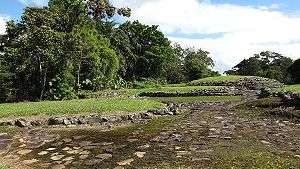
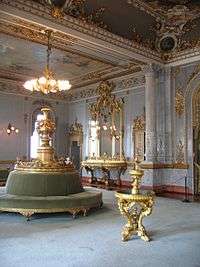
- Sarchí, Alajuela, for shopping souvenirs and typical products, including the popular Costa Rican ox carts.
- INBioparque, Instituto Nacional de Biodiversidad, Santo Domingo de Heredia.
- Lankester Botanical Garden, Cartago.
- Orosí Colonial Church and Ujarrás historical site, Cartago.
- Basílica de Nuestra Señora de los Angeles, (Basilica of Our Lady of the Angels), Cartago.
- Guayabo arqueologichal site, Turrialba, Cartago.
- Teatro Nacional de Costa Rica (National Theater), San José.
- Teatro Popular Melico Salazar (Popular Theater), San José.
- Centro Nacional de Arte y Cultura (National Center of Arts and Culture), San José.
- Museo Nacional de Costa Rica (National Museum), San José.
- Museo de Oro de Costa Rica Precolombino (Pre-Columbian Gold Museum), Central Bank of Costa Rica, San José.
- Museo de Jade, (Jade Museum), Instituto Nacional de Seguros en San José.
- Museo Filatélico de Costa Rica (Philately Museum)
- Museo Juan Santamaría en Alajuela
- Museo de los Niños, (Children Museum), San José.
- Parque Zoológico Nacional Simón Bolívar, (National Zoo), San José.
- Camino de Costa Rica (hiking trail across the country, from the Atlantic to the Pacific coast)
Medical Tourism
Costa Rica, together with Cuba, Mexico, Panama, Colombia, Brazil, and Chile, is among the Latin America countries that have become popular destinations for medical tourism.[62][63] In 2009 Costa Rica received 30,000 international tourists seeking for medical treatment, and spent around US$250 million. Most medical travelers came from the United States and Canada.[64] During 2010, the number of patients rose to 36,000 international tourists, with 40% of them receiving dental care services.[65] In 2011, that number continued to rise, eventually reaching 46,474.[66]
Costa Rica is particularly attractive to American tourists because of its proximity and short flight, the quality of medical services and its health care system, and lower medical costs.[63][67] The country has 20 medical centers, including small clinics and private hospitals, with international certification, including two hospitals accredited by the Joint Commission International.[64][67]
American tourists prefer Costa Rica, together with Mexico and Panama, for dental services or cosmetic surgeries. Costa Rica offers 30% to 50% savings as compared to U.S. costs for quality dental and cosmetic surgery services, and is attractive for those U.S. citizens without health insurance or seeking procedures not covered by their health insurance plans.[62][68] Foreign patients also find lower-priced nonsurgical procedures and tests, as an example, a magnetic resonance imaging (MRI) in Costa Rica costs from $200 to $300, compared to more than $1,000 in the United States.[62] In average medical costs are 70% lower than in the U.S.[64] Due to the country's natural attractions, many health tourists combine their treatment with ecotourism and offer an opportunity to their family or companions to be entertained while the patient undergoes the medical procedure.[63]
Environmental and social impacts
Beachfront developments
In many beach areas, but especially in the towns of Tamarindo and Jacó, a real estate boom took place when many foreigners from developed countries began buying beachfront properties and building holiday and vacation houses and condominiums. These developments completely changed the life style in these towns, and property prices are now so high that it became prohibitive for Costa Ricans to own beach front properties.[16] Also, the lack of planning for these developments is having a negative social impact on small communities, as in some cases they are forced to move to places with less adequate infrastructure and where not enough job opportunities exist.[69]
Hotel siting and construction
Also there have been isolated controversies regarding the site location and construction of hotels and beach resorts invading the 50 metres (160 ft) protected maritime public zone; also a case of one hotel located within a protected area; and a few cases of resort development with severe negative impacts to existing flora and fauna, by dumping construction wastes damaging coral reefs or filling mangroves.[16] As a result of these and other similar controversies, the Environment Law 7554 was passed in 1995 to require environmental impact studies before a hotel or any other development is authorized to begin construction.[70]
Another source of pollution is due to dumping untreated sewage into rivers that feed into the beach towns. In 2007 the Constitutional Court order the national and 34 local governments to stop dumping sewage into the Río Grande de Tárcoles, to restore the watershed to its unpolluted condition and to adopt an integrated solution to the wastewater problem.[71] Towns such as Jacó where tourism and real estate development has grown ten-fold since 2004 suffered a backslash in September 2008 when the government blamed the local government of Garabito for high levels of bacteria on the beach.[72]
More recently, controversy took place with the construction of the Sardinal-El Coco-Ocotal aqueduct by private developers, as the community of Sardinal protested violently because they fear that scarce drinking water will be diverted for the tourism developments whose owners are financing the pipeline.[73] As of May 2008, construction works were stopped by order of the local municipality.[74] Developers and the government authorities have explained the aqueduct is public, and that it will benefit not only the tourism developments but also the surrounding communities.[75][76] Controversy still persists regarding the real capacity of the Sardinal aquifer.
Sex tourism
The rapid growth of tourism also has the consequence of the country becoming a popular destination for sex tourism.[77][78][79][80] Despite the government and industry efforts, child sex trade has become a problem.[81][82] A study estimated that "up to 10% of tourists who come to Costa Rica engage in sex tourism", with as many as 10,000 sex workers involved, many of whom are immigrants.[83][84] Also it was reported that about 80% of the sex tourists are from the US.[85] This is largely because prostitution is not illegal but many of the activities surrounding it are indeed illegal,[86] such as pimping.[87][88]
See also
- Ecotourism in Costa Rica
- Guayabo archeological site
- Islands of Costa Rica
- List of airports in Costa Rica
- List of museums in Costa Rica
- National Parks of Costa Rica
- Visa policy of Costa Rica
References
- "THE TOP 77". New7Wonders. Archived from the original on 2009-07-10. Retrieved 2009-07-10. This is the list of the Top 77 nominees eligible for consideration by the Panel of Experts, that by July 21, 2009 will select the 28 Official Finalist Candidates.
- José Enrique Rojas (2004-12-29). "Turismo, principal motor de la economía durante el 2004" (in Spanish). La Nación. Retrieved 2011-10-29.
- Crist Inman (1997). "Impacts on Developing Countries of Changing Production and Consumption Patterns in Developed Countries: The Case of Ecotourism in Costa Rica" (PDF). INCAE, available at International Institute for Sustainable Development website. Archived from the original (PDF) on 2012-12-09. Retrieved 2008-06-10.
- Mario Calderón Castillo (2005). "El Turismo como Promotor del Crecimiento Económico Costarricense" (in Spanish). Revista Parlamentaria Digital. Asamblea Legislativa de Costa Rica. Archived from the original on 2008-06-01. Retrieved 2008-06-08.
- Departamento de Estadísticas ICT (2006). "Anuário Estadísticas de Demanda 2006" (PDF) (in Spanish). Intituto Costarricense de Turismo. Archived from the original (PDF) on 2011-03-02. Retrieved 2008-06-13.
- Departamento de Estadísticas ICT (2009). "Anuário Estadístico 2008" (PDF) (in Spanish). Intituto Costarricense de Turismo. Archived from the original (PDF) on 2010-04-01. Retrieved 2011-10-03.
- Marvin Barquero (2016-01-16). "País logra récords en divisas y visitantes por el turismo" [Country achieves record tourism visitors and earnings]. La Nación (in Spanish). Retrieved 2016-01-16.
- Jennifer Blanke and Thea Chiesa, Editors (2013). "Travel & Tourism Competitiveness Report 2013" (PDF). World Economic Forum, Geneva, Switzerland. Retrieved 2013-04-14. See Table 4, pp. 18 and Country/Economy Profile: Costa Rica, pp. 142-143.
- UNEP and UNWTO (2011). "Tourism - Investing in Energy and Resource Efficiency" (PDF). United Nations Environment Programme (UNEP). Retrieved 2011-10-28. See pp. 422 and 425.
- Departamento de Estadísticas ICT (2011). "Anuario Estadístico 2010" (PDF) (in Spanish). Instituto Costarricense de Turismo (ICT). Retrieved 2011-10-27.
- Mónica Vásquez Muñoz (2002). "Tourism and Conservation in Southern Costa Rica" (PDF). York University. Retrieved 2011-10-29.
- Earth Trends (2003). "Biodiversity and Protected Areas - Costa Rica" (PDF). World Resources Institute. Archived from the original (PDF) on 2008-06-25. Retrieved 2008-06-08.
- "Costa Rica National Parks and Reserves". World Headquarters. 2007. Retrieved 2008-06-08.
- Leonardo Coutinho and Otávio Cabral (2008-05-21). "O desafio da economia verde". Revista Veja (in Portuguese). Archived from the original on 2009-02-23. Retrieved 2008-06-08. Published on website "Planeta Sustentável"
- Leo Hickman (2007-05-26). "Shades of green". The Guardian. London. Retrieved 2008-06-08.
- Honey, Martha (1999). Ecotourism and Sustainable Development: Who Owns Paradise?. Island Press; 1 edition, Washington, D.C. pp. 128–181. ISBN 1-55963-582-7. Chapter 5. Costa Rica: On the Beaten Path
- Bruce Aylward; et al. (1996). "Sustainable ecotourism in Costa Rica: the Monteverde Cloud Forest Preserve". Biodiversity and Conservation. Biodiversity and Conservation vol 5, no. 3, 315-343. 5: 315–343. doi:10.1007/BF00051777.
- Sergio Arce (2011-05-30). "Ecoturismo y turismo médico, otros 'clusters'". La Nación (Costa Rica). Retrieved 2011-05-31.
- "Ethical travel destinations unveiled: Argentina, Barbados, Chile". The Independent. Relaxnews. 2010-12-10. Retrieved 2010-12-11.
- "The Developing World's 10 Best Ethical Destinations: 2012". Ethical Traveler. 2012-01-05. Retrieved 2012-01-26.
- Departamento de Estadística ATP (2019). "Resumen estadístico de enero a diciembre 2018" (PDF) (in Spanish). Autoridad de Turismo de Panamá (ATP). Retrieved 2019-08-15.
- Departamento de Investigación de Mercados INGUAT (2019). "Boletín estadístico anual 2018" (PDF) (in Spanish). Instituto Guatemalteco de Turismo (INGUAT). Retrieved 2019-08-15.
- "UNWTO World Tourism Barometer June 2008" (PDF). World Tourism Barometer. June 2008. Archived from the original (PDF) on 2008-10-31. Retrieved 2008-08-05. Data corresponds to 2007
- Hassel Fallas (2009-01-25). "Llegada de turistas cayó en los últimos seis meses" (in Spanish). La Nación. Archived from the original on 2009-01-30. Retrieved 2009-03-07.
- Marvin Barquero (2015-01-23). "Costa Rica busca atraer turistas con poder adquisitivo" [Costa Rica seeks to attract tourists with purchase power]. La Nación (in Spanish). Retrieved 2015-02-01.
- Andrea González (2013-03-08). "Visitas turisticas en el 2012 fueron las más altas de los últimos cinco años" [Tourist arrivals in 2012 the highest during the last five years]. La Nacion (in Spanish). Archived from the original on 2013-03-14. Retrieved 2013-03-11.
- Carmen Altés (2006). "El Turismo en América Latina y el Caribe y la experiencia del BID" (in Spanish). Inter-American Development Bank, Sustainable Development Department. Retrieved 2008-06-05. Technical Paper Series ENV-149, Washington, D.C., pp 9 and 47.|
- "País cerró el 2010 con el ingreso más alto de turistas". La Nación (Costa Rica) (in Spanish). 2011-01-17. Retrieved 2011-01-17.
- "UNWTO Tourism Highlights, Edition 2007" (PDF). World Tourism Organization. 2007. Archived from the original (PDF) on 2013-04-09. Retrieved 2008-03-29.
- "UNWTO Tourism Highlights - 2011 Edition" (PDF). World Tourism Organization. June 2011. Archived from the original (PDF) on 2012-01-05. Retrieved 2011-09-29.
- "UNWTO Tourism Highlights 2012 Edition" (PDF). World Tourism Organization (UNWTO). June 2012. Archived from the original (PDF) on 2012-07-09. Retrieved 2012-08-20. pp. 10
- "UNWTO Tourism Highlights, 2013 Edition" (PDF). World Tourism Organization (UNWTO). June 2013. Archived from the original (PDF) on 2013-11-27. Retrieved 2014-04-14. pp. 10
- "UNWTO Tourism Highlights, 2017 Edition". World Tourism Organization (UNWTO). August 2018. Retrieved 2019-08-18. pp. 17
- Sergio Arce (2010-02-24). "Llegada de turistas se redujo 8% en 2009" (in Spanish). La Nación. Archived from the original on 2010-02-27. Retrieved 2010-02-24.
- Roberto Crotti and Tiffany Misrahi, Editors (2017). "Travel & Tourism Competitiveness Report 2017" (PDF). World Economic Forum, Geneva, Switzerland. Retrieved 2019-08-18. See Table 1, pp. 25 and Country/Economy Profile: Costa Rica, pp. 150-151.
- Departamento de Estadísticas ICT (2013). "Anuario Estadístico de Turismo 2012" [Tourism Statistical Yearbook 2012] (PDF) (in Spanish). Instituto Costarricense de Turismo (ICT). Archived from the original (PDF) on 2015-07-15. Retrieved 2014-04-14. See tables 1, 63 and 64.
- Departamento de Estadísticas ICT (2019). "Anuario Estadístico de Turismo 2018" [Tourism Statistical Annuary] (in Spanish). Instituto Costarricense de Turismo (ICT). Retrieved 2019-08-15. See table 1 in both files.
- United Nations. "UNData. Country profiles (1999-2005)". Retrieved 2008-08-08. Population estimated for 2007 (search values for each country profile)
- World Tourism Organization (2006). "Tourism Market Trends, Annex 12, 2006 Edition" (PDF). Archived from the original (PDF) on 2019-02-20. Retrieved 2008-03-30. Data corresponds to 2005.
- "Informe de Encuestas IV Trimestre 2006. Aeropuerto Internacional Juan Santamaria" (in Spanish). Instituto Costarricense de Turismo. 2006. Archived from the original on 2008-10-03. Retrieved 2008-06-06. 2006 Annual Survey from the Costa Rican Board of Tourism (ICT)
- "Tourism for Tomorrow Awards 2009". World Travel & Tourism Council. 2009. Archived from the original on 2009-06-14.
- "Tourism for Tomorrow Awards 2006". World Travel & Tourism Council. 2006. Archived from the original on 2009-04-12.
- "Rainforest Alliance 2007 Sustainable Standard-Setter". Rainforest Alliance. 2007. Archived from the original on 2009-11-24.
- "Programa Bandera Azul Ecológica" (in Spanish). Guía Costa Rica. Archived from the original on 2008-06-15. Retrieved 2008-06-19.
- Peter Freeman (2007-03-14). "Blue Flags for green action" (PDF). The Journal. Archived from the original (PDF) on 2008-05-13. Retrieved 2008-06-19. pp. 10
- Lawrence Pratt and Naomi Olson (1997). "Sector Turístico en Costa Rica: Análisis de Sostenibilidad" (PDF). INCAE Business School Research CEN 760. Retrieved 2011-10-29.
- Ángela Ávalos (2008-03-26). "Ocho playas pierden Bandera Azul por contaminación" (in Spanish). La Nación. Archived from the original on 2008-03-29. Retrieved 2008-06-15.
- Luis Díaz (2010-03-26). "Solo dos de 61 playas obtienen cinco estrellas en Bandera Azul" (in Spanish). La Nación (Costa Rica). Retrieved 2010-03-28.
- Mercedes Agüero (2007-11-07). "ICT espera 2 millones de turistas a finales del 2008" (in Spanish). La Nación. Archived from the original on 2008-10-11. Retrieved 2008-06-15.
- Stater, Adam. "CST in Costa Rica".
- Hassel Fallas (2008-06-10). "ICT promoverá hoteles amigables con la naturaleza" (in Spanish). La Nación. Archived from the original on 2008-06-13. Retrieved 2008-06-15.
- "ICT promoverá hoteles amigables con la naturaleza" (in Spanish). La Nación. 2008-06-10. Retrieved 2008-06-15.
- "Cuatro hoteles más certifican sostenibilidad ambiental" (in Spanish). La Nación. 2009-10-28. Archived from the original on 2009-02-21. Retrieved 2009-10-28.
- Jane Esberg, Jeff Greenwald and Natalie Lefevre. "The Developing World's 10 Best Ethical Destinations". Ethical Traveler. Archived from the original on 2010-12-14. Retrieved 2010-12-11.
- Marvin Barquero (2012-11-02). "Siete resorts de Costa Rica se ubican entre los mejores de Centro y Suramérica" [Seven Costa Rican resorts among the best of Central and South America]. La Nación (in Spanish). Archived from the original on 2012-11-03. Retrieved 2012-11-02.
- Condé Nast Traveler (November 2012). "Readers' Choice Awards - Top 15 Resorts in Central & South America". Condé Nast Traveler. Archived from the original on 2012-10-21. Retrieved 2012-11-02.
- Condé Nast Traveler (November 2012). "Readers' Choice Awards - Top 5 Hotels in Central America". Condé Nast Traveler. Archived from the original on 2012-10-19. Retrieved 2012-11-02.
- ICT (May 2011). "Cifras Turísticas Mayo 2011" (PDF) (in Spanish). Instituto Costarricense de Turismo. Retrieved 2011-10-27. See table 4, pp. 4.
- Andrea Solano (2009-07-10). "Isla del Coco es finalista en concurso mundial". La Nacion (in Spanish). Archived from the original on 2009-07-14. Retrieved 2009-07-10.
- Jane Levere (2011-08-29). "The World's Most Beautiful National Parks". Forbes. Retrieved 2011-10-04.
- Randall Corella V. (2007-08-26). "Concurso 7 maravillas naturales de Costa Rica". La Nación (in Spanish). Archived from the original on 2012-04-25. Retrieved 2011-10-03.
- Herrick, Devon M. (2007). Medical Tourism: Global Competition in Health Care. National Center for Policy Analysis, Dallas, Texas. pp. 4–6, 9. ISBN 1-56808-178-2. Available in pdf Archived 2011-07-20 at the Wayback Machine
- Bookman, Milica Z.; Bookman, Karla R. (2007). Medical Tourism in Developing Countries. Palgrave Macmillan, New York. pp. 3–4, 58, 95, and 134–135. ISBN 978-0-230-60006-5.
- Sergio Arce (2011-05-02). "Costa Rica intenta atraer al turismo médico corporativo". La Nación (in Spanish). Retrieved 2011-05-13.
- Sergio Arce (2011-09-27). "Turismo médico crece por amplia demanda de servicios dentales". La Nación (in Spanish). Retrieved 2011-09-27.
- http://www.anywherecostarica.com/travel-guide/medical-tourism
- "Costa Rica Medical Tourism". Health-Tourism.com. Retrieved 2011-05-13.
- "Medical Tourism Statistics and Facts". Health-Tourism.com. Retrieved 2011-03-02.
- Hárold Brenes (2008-09-20). "Desarrollo de zonas costeras se da sin planificación social". La Nación (in Spanish). Retrieved 2008-09-20.
- "Secretaría Técnica Nacional Ambiental" (in Spanish). Secretaría Técnica Nacional Ambiental (SETENA). Archived from the original on 2011-11-07. Retrieved 2011-10-29.
- "Sala IV orders politicians to fix the sewer problem". A.M Costa Rica. 2007-05-07. Retrieved 2011-10-29.
- "Jaco in hot water about untreated sewage run-off". Surf in Jaco. 2008-11-18. Archived from the original on 2011-10-05. Retrieved 2011-10-29.
- Otto Vargas e Ingrid Morales (2008-05-13). "Grupo quema tubería y apedrea maquinaria en protesta por obra" (in Spanish). La Nación. Retrieved 2008-06-20.
- Marcela Cantero (2008-05-28). "Municipio suspende obras de acueducto en Sardinal" (in Spanish). La Nación. Retrieved 2008-06-20.
- Ángela Ávalos (2008-06-20). "Grupo defiende inversión en acueducto" (in Spanish). La Nación. Retrieved 2008-06-20.
- Álvaro Murillo (2008-05-29). "Gobierno dice que falló al explicar obras en Sardinal" (in Spanish). La Nación. Retrieved 2008-06-20.
- "Unos 130 sitios de internet promueven turismo sexual Costa Rica" (in Spanish). La Nación. 2004-12-05. Retrieved 2007-03-16.
- Otto Vargas (2004-12-04). "Agencias ofrecen en el exterior damas para vacaciones eróticas en Costa Rica" (in Spanish). La Nación. Retrieved 2007-03-16.
- Ángela Ávalos (2008-06-22). "Cien personas escapan de redes de tráfico de almas en Jacó" (in Spanish). La Nación. Archived from the original on 2008-06-26. Retrieved 2008-06-22.
- "Costa Rica Draws Sex Trade". The Miami Herald. 2009-10-13. Retrieved 2011-10-29.
- Wright, Phillip (2004-06-18). "Sex tourism: Lessons learned in Costa Rica". BBC News. Retrieved 2007-12-21.
- Kovaleski, Serge F. (2000-01-02). "Child Sex Trade Rises In Central America". Washington Post Foreign Service. Washington Post Foreign Service. Retrieved 2006-12-20.
- Otto Vargas (2008-04-07). "Red trajo al país más de 400 dominicanas para prostitución" (in Spanish). La Nación. Retrieved 2008-04-07.
- Schifter-Sikora, Jacobo (2006). Mongers in Heaven: Sexual Tourism and HIV Risk in Costa Rica and in the United States. University Press of America. ISBN 978-0-7618-3597-4.
- Schmidt, Blake (2007-07-27). "Businesses Say No to Sex Tourism Industry". Tico Time.
- Asamblea Legislativa de la República de Costa Rica. "Código Penal, Ley No. 4573 de 1970 y reformas hasta 26 de febrero de 2002" (PDF) (in Spanish). Retrieved 2007-03-17. see SECCIÓN III: Corrupción, proxenetismo, rufianería (Articles 167 to 172).
- "Promoción de la prostitución: Unos 130 sitios de internet promueven el turismo sexual de Costa Rica" (in Spanish). LaFlecha.net. 2004-12-07. Archived from the original on 2007-05-13. Retrieved 2007-03-17.
...prostitution is not penalized in the country, but a third-party soliciting clients for a prostitute (proxenetismo) is committing a crime
(free translation from Spanish) - "Country Reports on Human Rights Practices: Costa Rica". U.S. State Department. Retrieved 2007-09-28.
...There are no specific laws against sex tourism, which was growing
External links
| Wikivoyage has a travel guide for Costa Rica. |
- Costa Rica, Condé Nast Traveler
- Costa Rican Tourism Board (ICT) official web site
- Costa Rica's Certification in Sustainable Tourism Program
- Costa Rica National Parks
- Costa Rica Hotels & Resorts - Condé Nast Traveler Gold List 2014
- Costa Rica Guide, National Geographic
- New York Times Travel Guides: Costa Rica
- In Search of ‘Wild’ Costa Rica, The New York Times, 10 April 2014.

